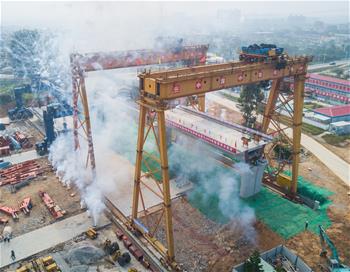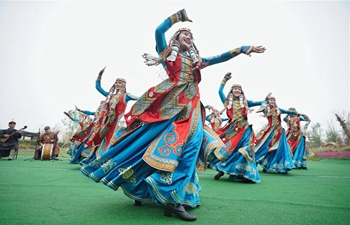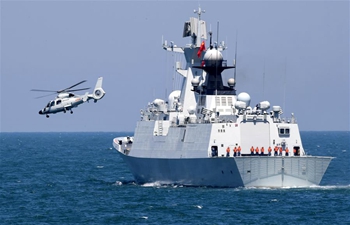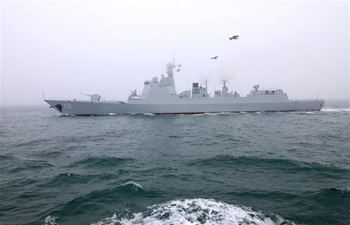
Qiu Yanpeng (C), chief director of "Joint Sea-2019" exercise from the Chinese side and deputy commander of the Chinese People's Liberation Army (PLA) Navy, delivers a speech at the welcome ceremony for Russian navy vessels in Qingdao, east China's Shandong Province, April 29, 2019. Russian naval vessels arrived in Qingdao on Monday to participate in the Sino-Russian "Joint Sea-2019" exercise. The exercise will focus on joint sea defense, which aims to consolidate and develop the China-Russia comprehensive strategic partnership of coordination, deepen pragmatic naval cooperation, and improve their capabilities to jointly respond to security threats at sea. Two submarines, 13 surface ships, as well as fixed-wing airplanes, helicopters and marines, will participate in the exercise. (Xinhua/Li Ziheng)
QINGDAO, April 29 (Xinhua) -- Russian naval vessels arrived in Qingdao, east China's Shandong Province, on Monday to participate in the Sino-Russian "Joint Sea-2019" exercise.
After the Russian cruiser Varyag arrived, the military band of the Chinese People's Liberation Army (PLA) Navy played the Russian and Chinese national anthems.
Qiu Yanpeng, chief director of the exercise from the Chinese side and deputy commander of the Chinese PLA Navy, said in his speech that the Chinese and Russian navies aim to achieve greater breakthroughs in the content, command and organization of the exercise to further deepen friendly cooperation between the two countries and the two armed forces.
Alexander Vitko, chief director of the exercise from the Russian side and deputy commander-in-chief of the Russian Navy, said he believed that with the exercise, officers and soldiers of both navies would improve their coordination with each other.
Set for April 29 to May 4 in nearby sea and airspace of Qingdao, the joint exercise will focus on joint sea defense, Ren Guoqiang, a spokesperson of the Ministry of National Defense, said earlier.
The exercise aims to consolidate and develop the China-Russia comprehensive strategic partnership of coordination, deepen pragmatic naval cooperation, and improve their capabilities to jointly respond to security threats at sea. The exercise does not target any third party, he said.
Two submarines, 13 surface ships, as well as fixed-wing airplanes, helicopters and marines, will participate in the exercise.















